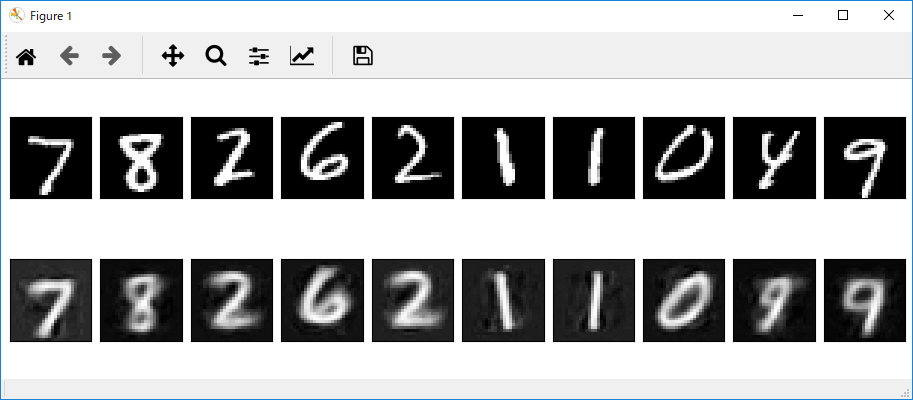|
SOL4Py Sample: TorchMNISTAutoEncoder
|

#******************************************************************************
#
# Copyright (c) 2018-2019 Antillia.com TOSHIYUKI ARAI. ALL RIGHTS RESERVED.
#
# This program is free software: you can redistribute it and/or modify
# it under the terms of the GNU General Public License as published by
# the Free Software Foundation, either version 3 of the License, or
# (at your option) any later version.
#
# This program is distributed in the hope that it will be useful,
# but WITHOUT ANY WARRANTY; without even the implied warranty of
# MERCHANTABILITY or FITNESS FOR A PARTICULAR PURPOSE. See the
# GNU General Public License for more details.
#
# You should have received a copy of the GNU General Public License
# along with this program. If not, see <http://www.gnu.org/licenses/>.
#
#******************************************************************************
# 2019/07/20
# TorchMNISTAutoEncoder.py
# This is based on the following sample program.
# https://pytorch.org/tutorials/beginner/blitz/cifar10_tutorial.html
# https://www.kaggle.com/tinydman/fashion-mnist-with-pytorch
# encodig: utf-8
import sys
import os
import time
import traceback
import matplotlib.pyplot as plt
import numpy as np
import torch
import torchvision
from torch.autograd import Variable
import torch.nn as nn
import torch.nn.functional as F
import torch.optim as optim
import torchvision.transforms as transforms
from torch.utils.data import DataLoader
from torchvision.datasets import MNIST, FashionMNIST
sys.path.append('../../')
from SOL4Py.ZMLModel import *
from SOL4Py.ZMain import *
from SOL4Py.torch.ZTorchSimpleAutoEncoderModel import ZTorchSimpleAutoEncoderModel
from SOL4Py.torch.ZTorchEpochChangeNotifier import ZTorchEpochChangeNotifier
from SOL4Py.torch.ZTorchModelCheckPoint import ZTorchModelCheckPoint
MNIST = 0
FASHION_MNIST = 1
############################################################
# Classifier Model clas
class TorchMNISTAutoEncoderModel(ZTorchSimpleAutoEncoderModel):
##
# Constructor
def __init__(self, image_size, n_classes, model_filename):
super(TorchMNISTAutoEncoderModel, self).__init__(image_size, n_classes, model_filename)
pass
def create_encoder(self):
self.encoder = nn.Sequential(
nn.Linear(self.size * self.size, 128),
nn.ReLU(True),
nn.Linear(128, 64),
nn.ReLU(True),
nn.Linear(64, 12),
nn.ReLU(True),
nn.Linear(12, 2))
def create_decoder(self):
self.decoder = nn.Sequential(
nn.Linear(2, 12),
nn.ReLU(True),
nn.Linear(12, 64),
nn.ReLU(True),
nn.Linear(64, 128),
nn.ReLU(True),
nn.Linear(128, self.size * self.size),
nn.Tanh()
)
class TorchMNISTAutoEncoder(ZMLModel):
IMAGE_SIZE = 28
CHANNELS = 1 #1: Gray scale
##
# Constructor
def __init__(self, dataset_id, epochs=0, mainv=None, ipaddress="127.0.0.1", port= 8888):
super(TorchMNISTAutoEncoder, self).__init__(dataset_id, mainv)
self.write("====================================")
self._start(self.__init__.__name__)
self.model_filepath = None
self.set_input_shape()
self.nclasses = 10
self.epochs = epochs
self.batch_size = 128
notifier = self.__class__.__name__+str("-") + str(self.dataset_id)
print("epochs {}".format(self.epochs))
self.callbacks = [ZTorchEpochChangeNotifier(ipaddress, port, notifier, int(self.epochs)+10),
ZTorchModelCheckPoint(dataset_id=dataset_id)]
self.model_filename = self.__class__.__name__ + "_" + str(self.dataset_id) + ".pt"
self.write(self.model_filename)
# Create training and validation transformer.
self.create_image_transformer()
self._end(self.__init__.__name__)
# Define your own create_image_transformer method in a subclass derived from this class if required.
def create_image_transformer(self):
self.train_transformer = transforms.Compose([transforms.ToTensor()])
self.valid_transformer = transforms.Compose([transforms.ToTensor()])
def build(self):
self._start(self.build.__name__)
try:
self.load_dataset()
self.create()
if self.is_trained() ==False:
self.train()
self.save()
else:
self.load()
except:
traceback.print_exc()
self._end(self.build.__name__)
def set_input_shape(self):
self.input_shape = (self.IMAGE_SIZE, self.IMAGE_SIZE, 1)
def set_dataset_id(self, dataset_id):
self.dataset_id = dataset_id
self.model_filename = self.__class__.__name__ + "_" + str(self.dataset_id) + ".pt"
#self.model = None
def load_dataset(self):
self._start(self.load_dataset.__name__)
if self.dataset_id == MNIST:
self.train_data = torchvision.datasets.MNIST("./data", train=True, download=True, transform=self.train_transformer)
self.train_loader = torch.utils.data.DataLoader(self.train_data,
batch_size=self.batch_size,
shuffle=True)
self.test_data = torchvision.datasets.MNIST("./data", train=False, download=True, transform=self.valid_transformer)
self.valid_loader = torch.utils.data.DataLoader(self.test_data,
batch_size=self.batch_size,
shuffle=False)
if self.dataset_id == FASHION_MNIST:
self.train_data = torchvision.datasets.FashionMNIST("./data", train=True, download=True, transform=self.train_transformer)
self.train_loader = torch.utils.data.DataLoader(self.train_data,
batch_size=self.batch_size,
shuffle=True)
self.test_data = torchvision.datasets.FashionMNIST("./data", train=False, download=True, transform=self.valid_transformer)
self.valid_loader = torch.utils.data.DataLoader(self.test_data,
batch_size=self.batch_size,
shuffle=False)
self._end(self.load_dataset.__name__)
def create(self):
self._start(self.create.__name__)
self.image_size = (1, self.IMAGE_SIZE, self.IMAGE_SIZE)
self.model_filename = self.__class__.__name__ + "_" + str(self.dataset_id) + ".pt"
self.model = TorchMNISTAutoEncoderModel(self.image_size, self.nclasses, self.model_filename )
self._end(self.create.__name__)
def train(self):
self._start(self.train.__name__)
start = time.time()
criterion = nn.MSELoss()
optimizer = optim.Adam(self.model.parameters(),lr=0.01, weight_decay=1e-5)
self.model.fit(self.train_loader,
self.valid_loader,
self.callbacks,
self.epochs,
criterion,
optimizer)
elapsed_time = time.time() - start
elapsed = str("Train elapsed_time:{0}".format(elapsed_time) + "[sec]")
self.write(elapsed)
self.model.summary()
self._end(self.train.__name__)
# Remove model file and weight file.
def clear(self):
if self.trained():
os.remove(self.model_filename)
self.model = None
def is_trained(self):
self._start(self.trained.__name__)
rc = False
if os.path.isfile(self.model_filename) == True:
self.write("Found model file:'{}'".format(self.model_filename))
rc = True
self._end(self.trained.__name__)
return rc
def predict(self, dataset_loader, n_sampling=10):
# Call self.model.predict method to get decoded_images from x_test image
return self.model.predict(dataset_loader, n_sampling=n_sampling)
def show_images(self, dataset_loader, decoded_images, n_sampling=10):
it = iter(dataset_loader)
n = n_sampling
fig = plt.figure(figsize=(n * 2, 4))
for i in range(1, n + 1):
images, labels = it.next()
# Display original x_test images
ax = plt.subplot(2, n, i)
npimage = images[0].numpy()
ch, h, w = npimage.shape
#print("src", npimage.shape)
plt.imshow(npimage.reshape(h, w))
plt.gray()
ax.get_xaxis().set_visible(False)
ax.get_yaxis().set_visible(False)
# Display decoded images predicted from original images.
ax = plt.subplot(2, n, i + n)
npimage = decoded_images[i-1].numpy()
#print("dec", npimage.shape)
plt.imshow(npimage.reshape(h, w))
plt.gray()
ax.get_xaxis().set_visible(False)
ax.get_yaxis().set_visible(False)
fig.tight_layout()
plt.show()
def save(self):
self._start(self.save.__name__)
self.model.save()
self._end(self.save.__name__)
def load(self):
self._start(self.load.__name__)
self.model.load_model()
self._end(self.load.__name__)
############################################################
#
#
if main(__name__):
try:
app_name = os.path.basename(sys.argv[0])
dataset_id = 0
epochs = 10
if len(sys.argv) >= 2:
dataset_id = int(sys.argv[1])
if len(sys.argv) == 3:
epochs = int(sys.argv[2])
model = TorchMNISTAutoEncoder(dataset_id=dataset_id, epochs=epochs)
model.build()
sampling = 10
decoded_images = model.predict(model.valid_loader, n_sampling=sampling)
model.show_images(model.valid_loader, decoded_images, n_sampling=sampling)
except:
traceback.print_exc()
Last modified:20 Sep. 2019
